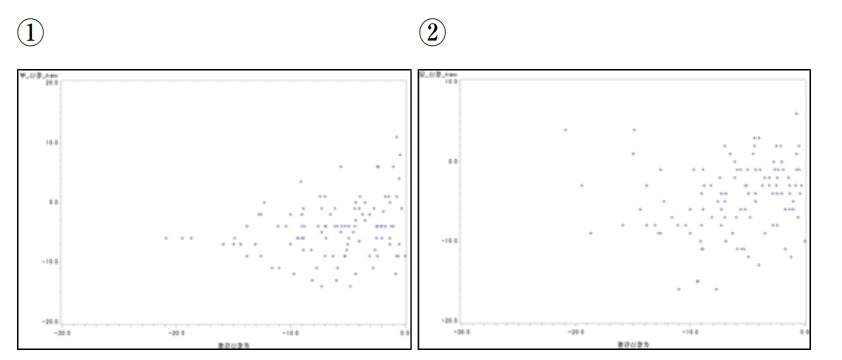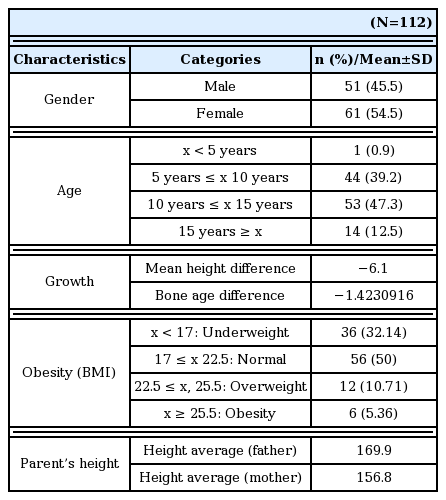References
1. Hong CH. Pediatric Seoul: Korean Textbook Co., Ltd; 2004. p. 22–6.
p. 978–89.
2. Lee KH. Pediatric Growth Assessment & Diagnosis of growth disorder. Korean Journal of Pediatrics 2003;46(2):1171–7.
3. Sin JH. Diagnosis and Treatment of Growth Disorders. Korean Journal of Pediatrics 1996;39(9):1201–9.
4. Cho HJ, Jung SM, Kim DG, Lee JY. Effects of Herbal Medicine on Growth of Children. Korean Journal of Oriental Pediatrics 2004;18(2):119–26.
5. Yang SW. Growth Hormone Treatment in Recent Growth Disorders. Korean Society of Endocrinology 2003;18:561–70.
6. Lee SH, Kim HJ, Heo BR. A Study on the Prevalence of Childhood Obesity. J of Family Medicine 1990;11(5):15–20.
7. Biro FM, Khoury P, Morrison JA. Influence ob obesity on timing of puberty. Int J Androl 2006;29(1):272–9.
8. Chavarro JE, Peterson KE, Sobol AM, Wiecha JL, Gortmaker SL. Effects of a school-based obesity-prevention intervention on menarche (United States). Cancer Causes Control 2005;16(10):1245–52.
9. Freedman DS, et al. The relation of menarcheal age to obesity in childhood and adulthood: the Bogalusa heart study. BMC Pediatr 2003;30. 3(1):3.
10. Wauters M, et al. Human leptin: from an adipocyte hormone to an endocrine mediator. Eur J Endocrinol 2000;143(3):293–311.
11. Biro FM, et al. Impact of timing of pubertal maturation on growth in black and white female adolescents: The National Heart, Lung and Blood Institute Growth and Health Study. J Pediatr 2001;138:636–43.
12. Dunkel L, Wickman S. Novel treatment of short stature with aromatase inhibitors. J Steriod Biochem Mol Biol 2003;86(3–5):345–56.
13. Shim JO. Underweight in Adolescents. Korean J Pediatr Gastroenterol Nutr 2011;14(Suppl 1):55–60.
14. Lee KH. Growth Hormone Therapy in Short Stature Children. J Korean Med Assoc 2008;51(9):849–55.
15. Koo YM. To What Extent Is Growth Hormone Therapy Morally Acceptable? J of the Korean Bioethics Association 2002;3(2):54–60.
16. Jung JH, Jung KM. A Study of Oriental Medicine on Growth of Children. J Korean Oriental Pediatrics 1996;10(1):1–15.
17. Jang KT, Kim JH. Literature Review on the Growth Disorder. 1997;11(1):1–35.
18. Jung YH, Kim YH, Yoo DY. The Literatual Study on the Growth Disorder. J Korean Oriental Pediatrics 1999;13(1):17–62.
19. Kim YT, Son YS, Jin SH, Han SW, Shim IS, Lim SB, Lee HI. The Effects of Cervus elaphus on the Growth and the Intellectual Development of Animals. J Korean Acupuncture & Moxibustion Society 2001;18(5):122–34.
20. Park BM, Soh KS, Jeong CG. Effects of Yukmiziwhang-whan on the Growth of Rats. J Korean Oriental Preventive Medical Society 2003;7(2):23–33.
21. Kang KW, Koh HK, Lee YH. The Effect of Nokyongsageunhwan Herbal Acupuncture and Oral Administration on the Growth and the Intellectual Development of Rats. J Korean Acupuncture & Moxibustion Society 2003;20(6):45–62.
22. Ku EJ, Kim DK. The effect of Boyangsengjang-Tang on the growth of mice and rats. J Korean Oriental Pediatrics 2002;16(1):149–70.
23. Lee DH, Kim DG. The effect of oriental medical care on Growth Deficiency Children. J Korean Oriental Pediatrics 1998;12(1):145–62.
24. Kim JH. The Clinical Study of Delayed Growth (I). J Korean Oriental Pediatrics 1998;12(1):95–110.
25. Lee JY, Jung MJ, Choi JM, Yu SA, Lee SY. Clinical trial study for failure to thrive in recent journals of Traditional Chinese Medicine. J Korean Oriental Pediatrics 2007;21(1):155–71.
26. Kyunghee University College of Oriental Medicine 45th graduate Graduation Preparation Committee Department of Academic Affairs. Practical approach to diagnosis of oriental medicine Seoul: Iljungsa; 1997. p. 201–25.
27. Committee for the Establishment of Standards for Child and Adolescent Physical Development. Korean Pediatric Society. Pediatric and Adolescent Standard Growth Chart Seoul: Disease Control Headquarters; 2007. p. 23–6.
28. Korean Society of Pediatric Endocrinology. Growth Pediatric endocrinology 2ndth ed. Seoul: Kwangmun Press; 2004. p. 36–56.
29. Jung HS, Lee H, Lee JY, Kim DG. Clinical Study of Effect to the Height-Growth after the Administration of Boyangsungjangtang to the Prepuberty Children. J Korean Oriental Pediatrics 2001;15(1):47–57.
30. Lee ML, Lee SH. A Study On The Development Of Teeth And The Bone Maturity Of Hand-Wrist During Pubertal Growth Period In Korean. Journal of the Korean academy of pediatric dentistry 1992;19(1):259–78.
31. Rosenfeld RG. Disorders of growth hormone and insulin-like growth factor secretion and action. In : Sperling MA, ed. J of Korean society of pediatric Endocrinology 2002. p. 116–69.
32. Kim KH, Kim HY, Kim DH, Yoon DJ. Clinical Observation on Dwarfism. Korean Journal of Pediatrics 1980;23:16–22.
33. Kim JB, You HO. Etiological Classifications of Children with Chief Complaint of Short Stature. J of Korean society of pediatric endocrinology 1997;2:1–9.
34. Lee MC, Kim MJ, Choi IJ, Cheuh HW, Yoo JH. Complementary Therapies and Perceptions of Growth in Parents and Children Visiting the Growth Clinic. J of Korean society of pediatric endocrinology 2008;13(1):73–80.
35. Lee JH. Growth Assessment of Children and Adolescents Complaining of Short Stature. Kosin University Medical Journal 2008;23:42–8.
36. Kwon EJ, Nah EH. Secular trends in height, weight and obesity among Korean children and adolescents in 2006–2015. Korean J Health Educ Promot 2016;33(2):1–13.
37. Ju JY, Choi JE, Kim KS. A Case Study on Effect of Herbal Diet an Childhood Obese Patient. J Korean Oriental Association for Study of Obesity 2003;3(1):69–74.
38. Kim KJ, Lee JS, Yoon JH, Ryu BH, Paik HY. The Weight Gain Effects of Sungjangjeungbo-tang on Thin Korean Preschool Children. Korean J Orient Int Med 2012;33(2):180–7.






